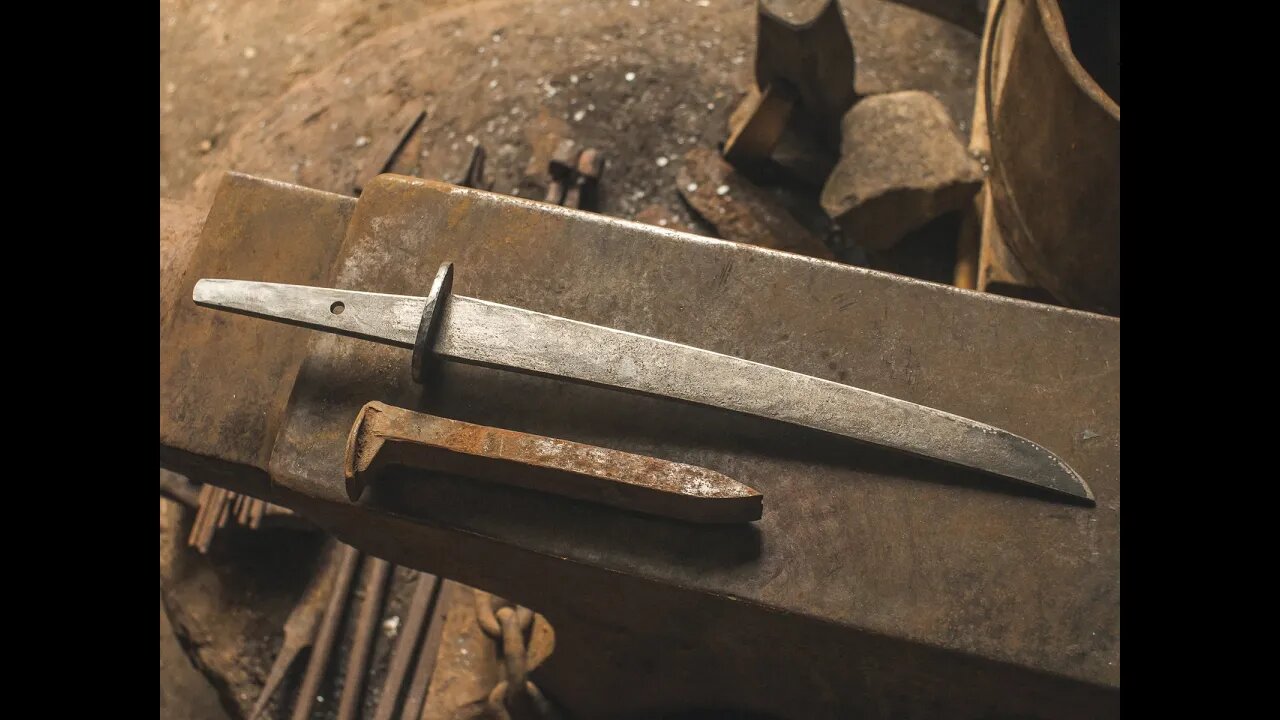Premium Only Content

TimeWarp #3 - Tanto Forging Practice: Railroad Spike
Hand forging a classical tanto style blade study from a reclaimed railroad spike and a tsuba from the spike head...a serious letter opener? (4x) The goal is to use all of the steel by moving it into place.
Serious students of the forge can watch the full process version here: https://youtu.be/0qU9wg_DVaY
This project was intended as purely a forging exercise to inspire those wishing to learn hand forging of sunobe and tanto, using an available source of scrap steel in a conveniently sized and shaped billet ("forge 10 of these and call me in the morning"). However as research into the composition and characteristics of railroad spike steel it has raised some interesting points which may lead to further research into koto swords.
First a note…
Don’t mess with the railway…if you don’t already have a spike this is not the practice material for you. The goal of this project is to use a material already on hand.
A review of some points...
High Carbon?
A railroad spike will never be "high carbon steel" as the accepted definition is that there is more than .5 or .6% carbon in high carbon steel (there are "higher carbon" versions of older spikes, but the official specs say they never pass .3% carbon)
Hardness?
A railroad spike with ~.3% carbon can be hardened with a water quench to about a maximum of 55HRC, this is not as hard as most knives, however it is about an axe hardness, much harder than mild steel which maxes out around 40HRC. Additionally, many old koto and earlier swords have ~.4% carbon, which can be hardened to around 60HRC but does not meet the definition of "high carbon steel"...a further note, i did a quick hitatsura (no clay) differential quench on this piece and it gained a fair amount of sori (curvature), which i did not expect from this steel...
Toughness?
For most applications it seems the best approach with a spike is to water quench and not temper at all, in order to stay at the maximum hardness for the carbon content. A spike heat treated in this way will still not quite pass the break test, meaning there is plenty of toughness at the full hardness.
Recommendations
I still do not recommend making knives from this material other than for personal use or novelty purposes. However, as a material for a spear or sword that would excel in the bronze or early iron age, or as a tool for the forge the material is far better than mild steel or wrought iron when heat treated properly.
Railroad spikes are a good source of material for those wishing to practice and improve forging of classical tanto without wasting high carbon steel...
The final blade dimensions are 10.75" (274mm) long and 1 1/8" (29mm) by just over 1/4" (7mm) at the mune machi...point to tang tip is 15".
長さ/刃長 Nagasa: 9 sun 5 rin (274mm)
元幅 Motohaba: 9 bu 5 rin (29mm)
重ね/元重 Motokasane: 2 bu 5 rin (7mm)
反り Sori: 1 bu 2 rin (3.5mm)
中心/茎 Nakago: 3 sun 5 bu (117mm)
形 Katachi: hira-zukuri, iori-mune
中心/茎 Nakago: futsu, kuri-jiri, one mekugi-ana
銘 Mei: mumei
Read more: http://islandblacksmith.ca/2016/07/tanto-forging-practice-railroad-spike/
A chart comparing carbon content and maximum possible hardness:
https://books.google.ca/books?id=fVIlbCFTodgC&pg=PA45&dq=%22However,+the+hardness+in+the+region+of+the+curves+representing+the+formation+of+all+martensite+will+be+determined+essentially+only+by+the+carbon+content+of+the+martensite.%22&hl=en&sa=X&ved=0ahUKEwjavNvfzeLNAhVX9WMKHcl6CxYQ6AEIHjAA#v=onepage&q=%22However%2C%20the%20hardness%20in%20the%20region%20of%20the%20curves%20representing%20the%20formation%20of%20all%20martensite%20will%20be%20determined%20essentially%20only%20by%20the%20carbon%20content%20of%20the%20martensite.%22&f=false
3.03022 cm
= 0.1 shaku(尺)
= 1 sun(寸)
= 10 bu(分)
= 100 rin(厘)
-
 LIVE
LIVE
Wendy Bell Radio
4 hours agoEnemy of the State
7,060 watching -

Chad Prather
19 hours agoThe Power You Cannot Buy: Motives, Power, and the Making of a True Disciple
59.8K17 -
 LIVE
LIVE
LFA TV
12 hours agoLIVE & BREAKING NEWS! | THURSDAY 12/04/25
2,879 watching -
 LIVE
LIVE
The Chris Salcedo Show
12 hours ago $3.54 earnedDispelling Narrative Over Facts On Racism
564 watching -
 16:09
16:09
T-SPLY
17 hours agoFederal Agents Arrest Non Citizen Police Officer — Department Hires Him BACK!
40.7K39 -
 12:55
12:55
World2Briggs
19 hours ago $4.66 earnedTop 10 States With The Worst Weather | Natural Disasters
24.4K -
 21:52
21:52
The King of Camo
21 hours agoGOALS 2026 Range Day
20.6K2 -
 48:22
48:22
A Cigar Hustlers Podcast Every Day
1 day agoEpisode 421 Cigar Hustlers Podcast Every Week Day Rage Bait
24.6K3 -
 2:05:49
2:05:49
BEK TV
1 day agoTrent Loos in the Morning - 12/04/2025
20K2 -
 2:55
2:55
Canadian Crooner
2 years agoPat Coolen | Christmas Blues
50.2K1